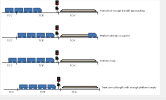No, "Lime Street Controls", for example from https://www.simsig.co.uk/Wiki/Show?page=usertrack:glossary:lime_street_control:Tunnel controls?
Does that mean there are limits on the number of trains allowed in the tunnelled sections up to Edge Hill?
Lime Street Control
Where a train is to be called-on into an occupied platform, it is obviously desirable that the platform be long enough to accommodate the additional train - especially in cases where the signaller is unable to see either the train, the platform, or both. Therefore, Lime Street Control uses a set of track circuits to approximately determine both platform space available and the length of the train approaching.
Because of the cost of track circuits, this method only works with certain combinations of trains. For example, at a particular London terminus, each platform has a 4-carriage length track circuit at the signal end of the platform (let's call it TC'A'), and a 4-carriage length measuring track on the station approach signal (let's call it TC'B'), and an additional track approaching the measuring track (let's call it TC'C'). The conditions for the calling-on aspect to be shown are therefore (TC'A' clear) and (TC'B' occupied) and (TC'C' clear), along with the usual conditions.
In the example above, with just a light engine at the buffer stops and a five car train approaching, the signal will never clear to a calling-on aspect as the equipment is only set up to measure the final four carriages possible. Other stations may have a 4-car and an 8-car (for example) set of measuring tracks and platform tracks but these are more rare due to the expense and complexity.
At Victoria Central, the track circuit information for the platforms is as above, but it is possible to get the calling on signal for an 8-car arriving train. If you are not careful, then it is possible to put an 8-car arriving train on top of an 8-car stabled train in a 12-car platform!

History from https://reference.swindonpanel.org.uk/index.php/Signalling_Controls:
EDIT What I take the post from Trothy to mean is that the implementation of "Lime Street Controls" at Lime Street prevents certain train movements devised by the planners in Milton Keynes because the latter are not sufficiently aware of the details of how the system works.The checking by virtue of track circuits being occupied and clear, that there is sufficient room in a partially-occupied platform to accommodate a second train. Track circuits of a known length are provided in the platform line and in rear of the previous signal to achieve this.
On 31 July 1924 the 2.40pm Euston-Liverpool arrived on platform 7 at Liverpool Lime Street and crashed into a light engine that was standing half-way down the platform. The signalman was not aware of the light locomotive's presence. A recommendation from this accident was the fitting of track circuiting, which has since developed further into using track circuits to 'measure' trains.
Last edited:
